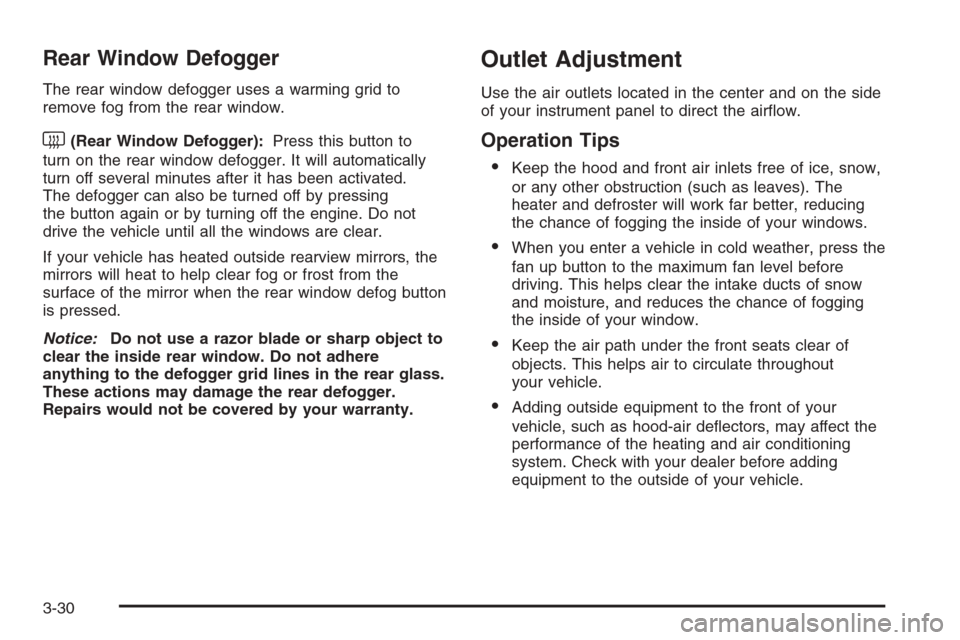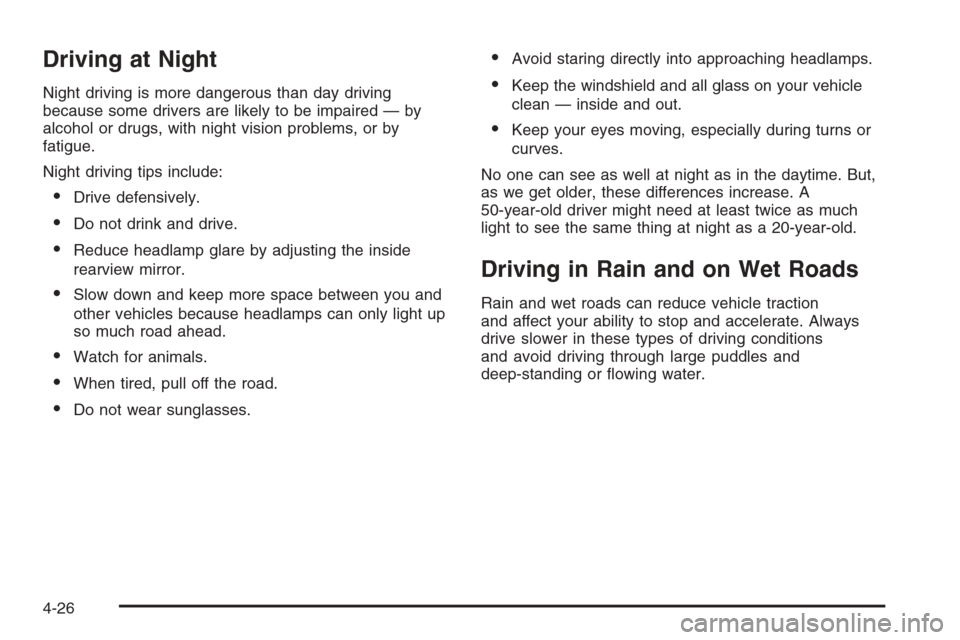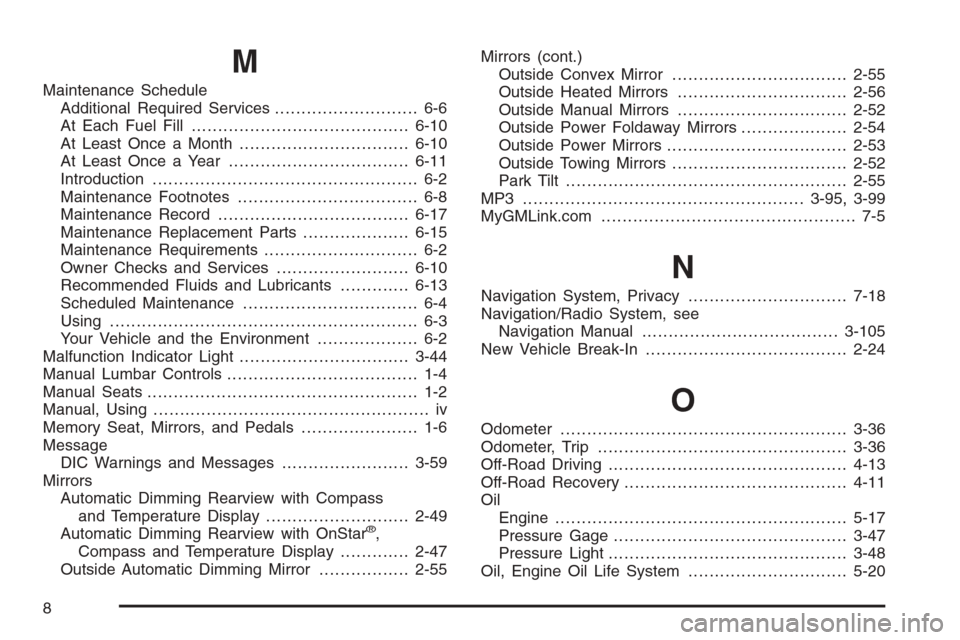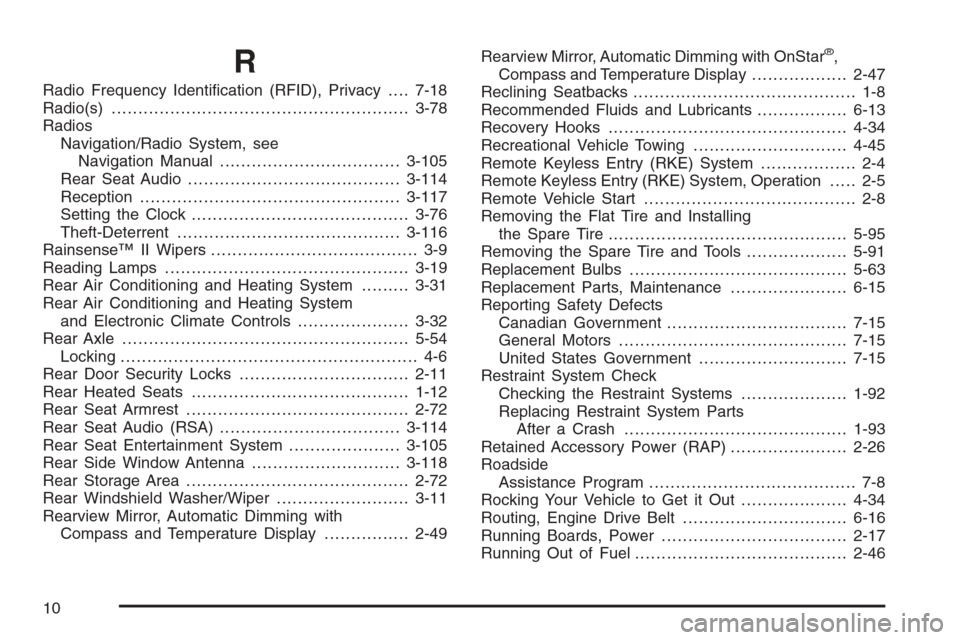2008 CHEVROLET SUBURBAN rear view mirror
[x] Cancel search: rear view mirrorPage 204 of 538

Rear Window Defogger
The rear window defogger uses a warming grid to
remove fog from the rear window.
<(Rear Window Defogger):Press this button to
turn on the rear window defogger. It will automatically
turn off several minutes after it has been activated.
The defogger can also be turned off by pressing
the button again or by turning off the engine. Do not
drive the vehicle until all the windows are clear.
If your vehicle has heated outside rearview mirrors, the
mirrors will heat to help clear fog or frost from the
surface of the mirror when the rear window defog button
is pressed.
Notice:Do not use a razor blade or sharp object to
clear the inside rear window. Do not adhere
anything to the defogger grid lines in the rear glass.
These actions may damage the rear defogger.
Repairs would not be covered by your warranty.
Outlet Adjustment
Use the air outlets located in the center and on the side
of your instrument panel to direct the air�ow.
Operation Tips
Keep the hood and front air inlets free of ice, snow,
or any other obstruction (such as leaves). The
heater and defroster will work far better, reducing
the chance of fogging the inside of your windows.
When you enter a vehicle in cold weather, press the
fan up button to the maximum fan level before
driving. This helps clear the intake ducts of snow
and moisture, and reduces the chance of fogging
the inside of your window.
Keep the air path under the front seats clear of
objects. This helps air to circulate throughout
your vehicle.
Adding outside equipment to the front of your
vehicle, such as hood-air de�ectors, may affect the
performance of the heating and air conditioning
system. Check with your dealer before adding
equipment to the outside of your vehicle.
3-30
Page 318 of 538

Driving at Night
Night driving is more dangerous than day driving
because some drivers are likely to be impaired — by
alcohol or drugs, with night vision problems, or by
fatigue.
Night driving tips include:
Drive defensively.
Do not drink and drive.
Reduce headlamp glare by adjusting the inside
rearview mirror.
Slow down and keep more space between you and
other vehicles because headlamps can only light up
so much road ahead.
Watch for animals.
When tired, pull off the road.
Do not wear sunglasses.
Avoid staring directly into approaching headlamps.
Keep the windshield and all glass on your vehicle
clean — inside and out.
Keep your eyes moving, especially during turns or
curves.
No one can see as well at night as in the daytime. But,
as we get older, these differences increase. A
50-year-old driver might need at least twice as much
light to see the same thing at night as a 20-year-old.
Driving in Rain and on Wet Roads
Rain and wet roads can reduce vehicle traction
and affect your ability to stop and accelerate. Always
drive slower in these types of driving conditions
and avoid driving through large puddles and
deep-standing or �owing water.
4-26
Page 320 of 538

Before Leaving on a Long Trip
To prepare your vehicle for a long trip, consider having
it serviced by your dealer/retailer before departing.
Things to check on your own include:
Windshield Washer Fluid:Reservoir full? Windows
clean — inside and outside?
Wiper Blades:In good shape?
Fuel, Engine Oil, Other Fluids:All levels checked?
Lamps:Do they all work and are lenses clean?
Tires:Are treads good? Are tires in�ated to
recommended pressure?
Weather and Maps:Safe to travel? Have
up-to-date maps?
Highway Hypnosis
Always be alert and pay attention to your surroundings
while driving. If you become tired or sleepy, �nd a
safe place to park your vehicle and rest.
Other driving tips include:
Keep the vehicle well ventilated.
Keep interior temperature cool.
Keep your eyes moving — scan the road ahead
and to the sides.
Check the rearview mirror and vehicle instruments
often.
4-28
Page 532 of 538

M
Maintenance Schedule
Additional Required Services........................... 6-6
At Each Fuel Fill.........................................6-10
At Least Once a Month................................6-10
At Least Once a Year..................................6-11
Introduction.................................................. 6-2
Maintenance Footnotes.................................. 6-8
Maintenance Record....................................6-17
Maintenance Replacement Parts....................6-15
Maintenance Requirements............................. 6-2
Owner Checks and Services.........................6-10
Recommended Fluids and Lubricants.............6-13
Scheduled Maintenance................................. 6-4
Using.......................................................... 6-3
Your Vehicle and the Environment................... 6-2
Malfunction Indicator Light................................3-44
Manual Lumbar Controls.................................... 1-4
Manual Seats................................................... 1-2
Manual, Using.................................................... iv
Memory Seat, Mirrors, and Pedals...................... 1-6
Message
DIC Warnings and Messages........................3-59
Mirrors
Automatic Dimming Rearview with Compass
and Temperature Display...........................2-49
Automatic Dimming Rearview with OnStar
®,
Compass and Temperature Display.............2-47
Outside Automatic Dimming Mirror.................2-55Mirrors (cont.)
Outside Convex Mirror.................................2-55
Outside Heated Mirrors................................2-56
Outside Manual Mirrors................................2-52
Outside Power Foldaway Mirrors....................2-54
Outside Power Mirrors..................................2-53
Outside Towing Mirrors.................................2-52
Park Tilt.....................................................2-55
MP3 .....................................................3-95, 3-99
MyGMLink.com................................................ 7-5
N
Navigation System, Privacy..............................7-18
Navigation/Radio System, see
Navigation Manual.....................................3-105
New Vehicle Break-In......................................2-24
O
Odometer......................................................3-36
Odometer, Trip...............................................3-36
Off-Road Driving.............................................4-13
Off-Road Recovery..........................................4-11
Oil
Engine.......................................................5-17
Pressure Gage............................................3-47
Pressure Light.............................................3-48
Oil, Engine Oil Life System..............................5-20
8
Page 534 of 538

R
Radio Frequency Identi�cation (RFID), Privacy....7-18
Radio(s)........................................................3-78
Radios
Navigation/Radio System, see
Navigation Manual..................................3-105
Rear Seat Audio........................................3-114
Reception.................................................3-117
Setting the Clock.........................................3-76
Theft-Deterrent..........................................3-116
Rainsense™ II Wipers....................................... 3-9
Reading Lamps..............................................3-19
Rear Air Conditioning and Heating System.........3-31
Rear Air Conditioning and Heating System
and Electronic Climate Controls.....................3-32
Rear Axle......................................................5-54
Locking........................................................ 4-6
Rear Door Security Locks................................2-11
Rear Heated Seats.........................................1-12
Rear Seat Armrest..........................................2-72
Rear Seat Audio (RSA)..................................3-114
Rear Seat Entertainment System.....................3-105
Rear Side Window Antenna............................3-118
Rear Storage Area..........................................2-72
Rear Windshield Washer/Wiper.........................3-11
Rearview Mirror, Automatic Dimming with
Compass and Temperature Display................2-49Rearview Mirror, Automatic Dimming with OnStar
®,
Compass and Temperature Display..................2-47
Reclining Seatbacks.......................................... 1-8
Recommended Fluids and Lubricants.................6-13
Recovery Hooks.............................................4-34
Recreational Vehicle Towing.............................4-45
Remote Keyless Entry (RKE) System.................. 2-4
Remote Keyless Entry (RKE) System, Operation..... 2-5
Remote Vehicle Start........................................ 2-8
Removing the Flat Tire and Installing
the Spare Tire.............................................5-95
Removing the Spare Tire and Tools...................5-91
Replacement Bulbs.........................................5-63
Replacement Parts, Maintenance......................6-15
Reporting Safety Defects
Canadian Government..................................7-15
General Motors...........................................7-15
United States Government............................7-15
Restraint System Check
Checking the Restraint Systems....................1-92
Replacing Restraint System Parts
After a Crash..........................................1-93
Retained Accessory Power (RAP)......................2-26
Roadside
Assistance Program....................................... 7-8
Rocking Your Vehicle to Get it Out....................4-34
Routing, Engine Drive Belt...............................6-16
Running Boards, Power...................................2-17
Running Out of Fuel........................................2-46
10